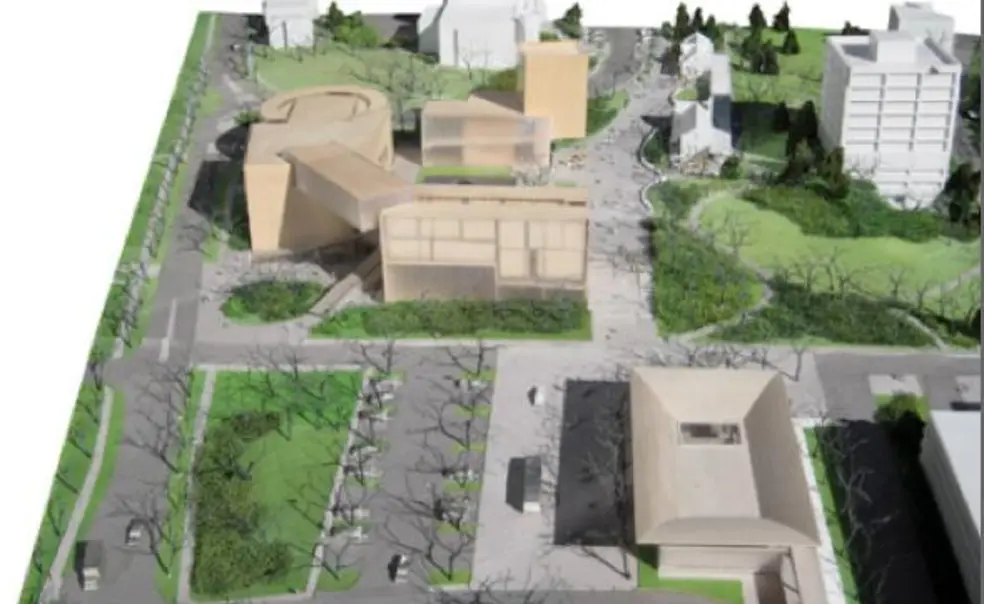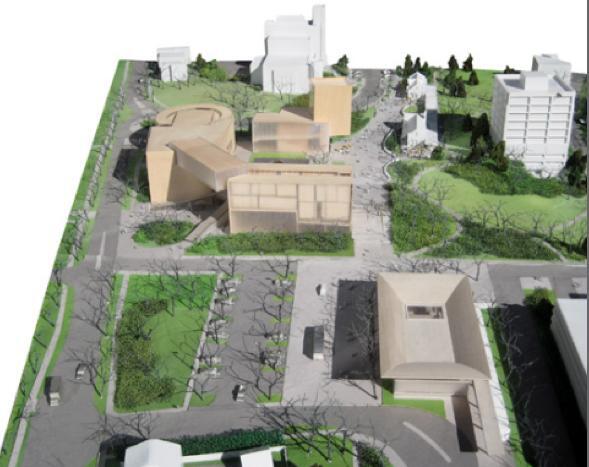After a 'go/no-go moment,' arts center plan in jeopardy
Princeton appeared ready to abandon its plan for a $300 million arts and transit project near McCarter Theatre — four years in the making — after local governing bodies Jan. 31 refused to endorse a necessary zoning change.
“This is a go/no-go moment for the University,” President Tilghman said at a special meeting of the Township Committee, the Borough Council, and the Planning Board. If the officials did not indicate that they would send the plan on for the required approvals, she said, she would instruct University colleagues to begin looking in the morning for another site where space for the arts could be built.
The local officials balked — particularly after residents in the overflow crowd reminded them that the meeting had been billed as an informational session at which no action would be taken.
After the session, University officials said they were prepared to abandon the project and look for another location. But in the days that followed, Princeton signaled that the door might still be open to working with local officials on the plan — at least temporarily.
At the tension-filled January meeting, about 200 people packed the Township Committee room, with others watching the events on a screen down the hall. Virtually everyone seemed to support the University’s plan to build a 137,000-square-foot home for the Lewis Center for the Arts and develop the neighborhood. But its proposal to move the Dinky 460 feet south — in what Vice President and Secretary Robert K. Durkee ’69 termed an essential aspect of the plan — was another story.
Tilghman and Durkee pointed out that the plan met all planning goals for the area, portions of which are located in each municipality. In addition to enhancing the arts for students and the community, they stressed that the University-funded improvements would benefit sustainability, traffic flow, retail development, and the appearance of the “gateway” to Princeton. They said the plan — which has the support of New Jersey Gov. Chris Christie — offered the best chance to shore up state support for the Dinky, which remains vulnerable to budget cuts.
Each side brought plenty of support. Tilghman sat at the front of the room with senior University administrators and two trustees; many Princeton faculty and staff members were in the audience. The University presented letters endorsing the project from the governor, state agencies, McCarter Theatre, and environmental, preservation, and arts groups. Several union leaders spoke on the plan’s behalf, saying it would create hundreds of jobs.
On the other side, supporters of “Save the Princeton Dinky” — a Facebook group with more than 7,000 members — and the Princeton Future community-planning group pressed for a way to build the project without moving the Dinky, saying that a move could decrease ridership and pull activity away from downtown. (University officials said that the alternatives presented, including grade crossings or a tunnel, were not feasible because of expense, liability, and other reasons.)
Ironically, while public opposition centered on the Dinky, the University does not require a zoning change to move the station, Durkee said. The change is needed for the new building.
Though the University has increased its financial support for surrounding municipalities in recent years — with voluntary contributions to the township of $500,000 this year and to the borough of more than $1.18 million — the tone of the meeting suggested that a chill in relations could be in the air.
Borough Councilman Roger Martindell said University officials had “come to us in bully-like fashion” to present an “ultimatum” on the arts plan. But Borough Mayor Mildred Trotman offered more conciliatory comments to Town Topics a week later: “I feel sure something can happen to move this forward,” Trotman said, adding that the proposal was “too great an opportunity, and the site location too ideal ... not to try and work together.”
Durkee said the University was willing to give local officials 60 days to come back with “a proposal that provides us with some real confidence that the project can go forward on a reasonable timeframe.” The Dinky relocation was not negotiable, he said: “If the University is going to invest $300 million in the project, we are not going to do this with a train in the middle of it.”
Failure to approve zoning for one of the University’s top priorities, Durkee said, would be evidence that there is “not a lot of shared vision or shared objectives” among the municipalities and the University. “When looking at the contributions the University makes [to the towns], why would we be inclined to be more generous — or even as generous — as in the past?” he asked.
After the session, Durkee said the University would seek to develop the area around McCarter in ways that did not require a zoning change — and that the Dinky station “will probably go further south” eventually.
In announcing plans for a new center for the arts four years ago, Tilghman cited two possible locations: the area south of McCarter Theatre, or a location that would include 185 Nassau Street and Frick and Green Halls, both of which are to be vacated as new buildings house the chemistry and psychology departments. Durkee said it would be premature at this point to discuss alternate locations.













3 Responses
Alan McKenney ’75
9 Years AgoBeing part of an elite
The conflict between the University and the borough described in the March 2 Campus Notebook article is saddening but not surprising. The University community — students, faculty, and administration — on the whole tends not to think about the community outside the campus, except when forced to. It was that way when I was a student, it was that way when I was a resident of the borough, and evidently it’s no different today.
So it’s not surprising that the University’s planned arts center does not take into account the needs of non-University residents — commuters, in particular — or that it was presented with so little consideration as to how borough residents predictably would react. Robert K. Durkee ’69’s comments, as quoted in the article, come off as particularly arrogant (not to mention inexpedient), but they reflect the University’s attitude: that doing what is good for itself (the University) is ipso facto good, and how it may affect those outside is irrelevant.
If this were just another case of gown vs. town, it wouldn’t be worth a letter. But Princeton turns out people who are going to be running (and often ruining) large chunks of the world. They are spending four very formative years surrounded by the unspoken attitude that being part of an elite means you don’t have to think about those who aren’t part of your elite. It seems to me that this can hardly result in anything you could call “in the world’s service” except by accident. It isn’t even all that sustainable: We’ve recently seen a number of regimes that were based on the same principle go down in flames.
Michael A. Fragoso ’06
9 Years AgoElitism and the arts plan
I was interested to read Alan McKenney ’75’s letter of April 6 decrying the attitudes of elitism allegedly fostered at Princeton. While Mr. McKenney’s broader point — that Princeton teaches students primarily to concern themselves with the interests/concerns of Princeton University due to some tribal class preference — may well be correct, that he managed to derive this from “town-gown” relations does not lend credibility to the argument.
Princeton Borough occupies one of the toniest ZIP codes in New Jersey, with very high median household income and home values. Of course, any drive up Witherspoon Street will show that the borough — despite its progressive politics — is a shockingly segregated community with a real gap between the (mostly) white “haves” and the (mostly) African-American and Hispanic “have-nots.”
Perhaps if the Salvadoran community were opposed to the “arts neighborhood” proposed by the University, then Mr. McKenney would have a point about “elite” Princeton behaving arrogantly toward the other. Yet the March 2 Campus Notebook article about the arts center offers no proof of this and, indeed, posits that moving the Dinky might foster “retail development” that presumably would favor the local working poor. In the end, I doubt that the local Hispanic immigrants stand to lose nearly as much as the wealthy of Hodge Road and Library Place who paid handsomely for — among other things — the convenience of the Dinky as we now know it.
Is Princeton elitist? Perhaps. Even if it is, that has little bearing on an intra-elite problem like planning to move the Dinky, which should be evaluated on the merits of the plan rather than on which very privileged groups are behaving badly toward each other.
Richard Trenner ’70
9 Years AgoDinky move no big deal
According to a study reported in Road Engineering Journal, the average walking speed of pedestrians 65 years and older is 4.11 feet a second. At that speed, you would need a bit under two minutes to walk the 460 feet from where the Princeton Borough Dinky station stands to where the University proposes to build a new station. If the location of the Dinky station is truly the deal-breaker for the long-debated arts and transit neighborhood (Campus Notebook, March 2), then what’s the big deal? The members of the University community and of the surrounding communities would be immensely fortunate to have access to a superb new arts neighborhood in Princeton. “All art,” said Leo Tolstoy, “has this characteristic: It unites people.” Let us hope so. And let us all unite behind art.